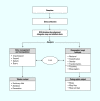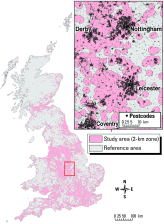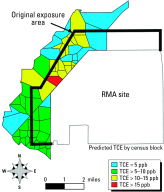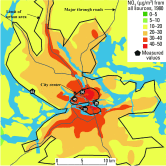Using geographic information systems for exposure assessment in environmental epidemiology studies
- PMID: 15198921
- PMCID: PMC1247194
- DOI: 10.1289/ehp.6738
Using geographic information systems for exposure assessment in environmental epidemiology studies
Abstract
Geographic information systems (GIS) are being used with increasing frequency in environmental epidemiology studies. Reported applications include locating the study population by geocoding addresses (assigning mapping coordinates), using proximity analysis of contaminant source as a surrogate for exposure, and integrating environmental monitoring data into the analysis of the health outcomes. Although most of these studies have been ecologic in design, some have used GIS in estimating environmental levels of a contaminant at the individual level and to design exposure metrics for use in epidemiologic studies. In this article we discuss fundamentals of three scientific disciplines instrumental to using GIS in exposure assessment for epidemiologic studies: geospatial science, environmental science, and epidemiology. We also explore how a GIS can be used to accomplish several steps in the exposure assessment process. These steps include defining the study population, identifying source and potential routes of exposure, estimating environmental levels of target contaminants, and estimating personal exposures. We present and discuss examples for the first three steps. We discuss potential use of GIS and global positioning systems (GPS) in the last step. On the basis of our findings, we conclude that the use of GIS in exposure assessment for environmental epidemiology studies is not only feasible but can enhance the understanding of the association between contaminants in our environment and disease.
Figures





References
-
- Ali M, Emch M, Donnay JP. Spatial filtering using a raster geographic information system: methods for scaling health and environmental data. Health Place. 2002;8:85–92. - PubMed
-
- ATSDR. 1996. Reproductive, Neurobehavioral, and other Disorders in Communities Surrounding the Rocky Mountain Arsenal. A Report by the Agency for Toxic Substances and Disease Registry and Colorado State University. Publ no PB96-178058. Springfield, VA:National Technical Information Service.
-
- AWWA 2000. Identifying Geographic Regions for Potential Future Epidemiology Research on Disinfection Byproducts. Rep no 341. American Water Works Research Foundation. Denver, CO:American Water Works Association.
-
- Bell EM, Hertz-Picciotto I, Beaumont J. A case-control study of pesticides and fetal death due to congenital anomalies. Epidemiology. 2001;12:148–156. - PubMed
Publication types
MeSH terms
Substances
LinkOut - more resources
Full Text Sources

